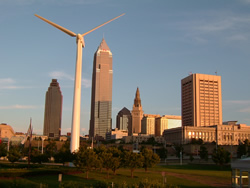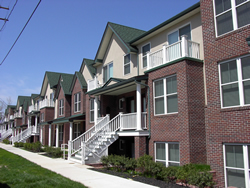 |

The Citywide Plan promotes creation of renewable energy resources that take advantage of our natural assets and minimize negative environmental impacts. [wind turbine at the Great Lakes Science Center] | SUSTAINABILITY
GOAL: Ensure the long-term environmental, economic and social viability of Cleveland and its region
Issues
A “sustainable Cleveland” is a community that meets the needs of the present without compromising the future. Because past generations lacked the understanding and the capabilities to achieve this, today we must address the consequences of actions that have, in fact, compromised our “present.” These consequences include, among others, contaminated brownfield sites, urban sprawl, over-dependence on the automobile, energy-wasting buildings, poor water quality, and unhealthy lifestyles associated with unhealthful development patterns.
Sustainability, however, requires even more than protection of our natural environment and our physical health. Just as important is the commitment to the minds of our children and all Clevelanders – providing them with the education that will enable them to adapt to ever-changing economic and social circumstances. In this sense, an educated community is a sustainable community, just as much as a healthy community is a sustainable community. |
|

?Greenbuilding? techniques can contribute to creating sustainable communities in Cleveland. [EcoVillage townhouses in Detroit-Shoreway] |
Policies
- Sustainable Development Patterns. Create high-density, mixed-use districts that promote travel by transit, walking and bicycling.
- Sustainable Neighborhoods. Develop “full life-cycle neighborhoods” that provide housing and services for residents of all ages and incomes, with a healthful living environment and convenient access to jobs, shopping and recreation.
- Sustainable Economy. Ensure that economic development, job training and education in the Cleveland region keep pace with national trends and emerging opportunities in order to provide jobs for current and future residents.
- Sustainable Development Practices. Ensure that land is used in a manner that preserves and expands valuable open space, protects natural habitats, retains and replaces trees, prevents environmental contamination, and protects sensitive lands.
- High Performance/ Green Building. Amend building and zoning codes and add financial incentives to encourage high performance “green building” that conserves resources and creates more healthful living and working environments.
- Nonmotorized Travel. Design and develop safe routes for walking and bicycling, accessible to all residents, in order to reduce automobile dependency, improve health, and reduce the cost of travel.
- Motorized Travel. Continue to upgrade current bus fleets with cleaner-burning vehicles and accelerate the replacement of vehicles in government and corporate fleets with more fuel-efficient and cleaner-burning vehicles.
- Mass Transit. Increase use of mass transit through such initiatives as employer incentives, park-and-ride lots, and transit-oriented development projects.
- Energy Conservation. Reduce use of energy and water in City facilities and vehicles and encourage similar practices by residents, businesses and other organizations.
- Renewable Energy. Promote use of solar, wind, geothermal and other renewable energy resources.
- Brownfield Remediation. Clean contaminated “brownfield” sites and promote beneficial re-use through regulatory action and increased funding to improve Cleveland’s environmental and economic health.
- Recycling and Waste Management. Reduce waste disposal through municipal curbside recycling and programs for recycling tires, motor oil, yard waste, electronic equipment, demolition debris, and roadway materials, as well as by encouraging consumers to make choices that are less wasteful of resources.
- Water Quality. Improve regional water quality by better managing stormwater runoff, strictly enforcing emission controls, reducing use of harmful lawn-care chemicals, restoring urban streams and rivers.
- Air Quality. Improve regional air quality by strictly enforcing emission controls, increasing alternative energy production, and promoting use of mass transit, nonmotorized travel, and cleaner-powered vehicles.
|
Continue to the Next Section: Goals & Policies: Preservation |
 |





